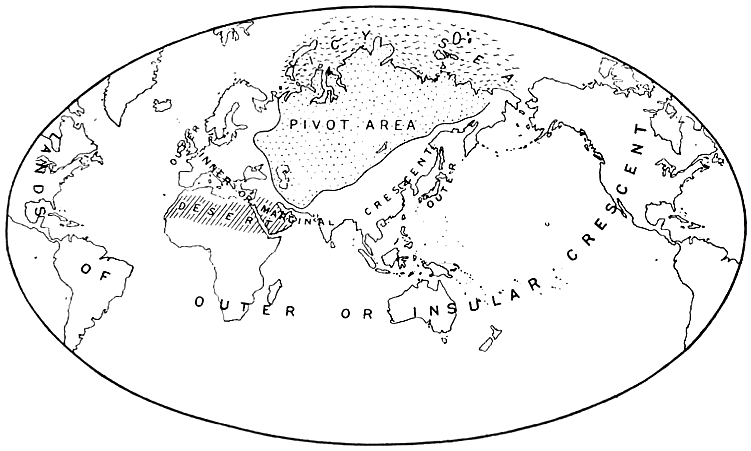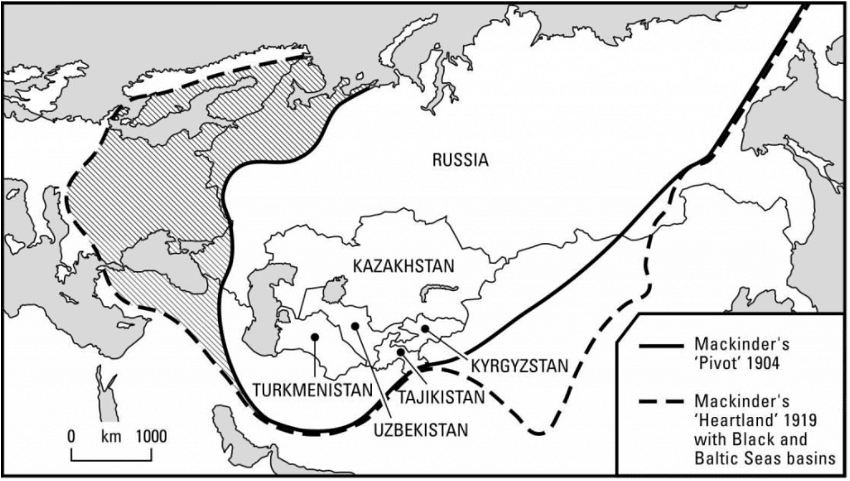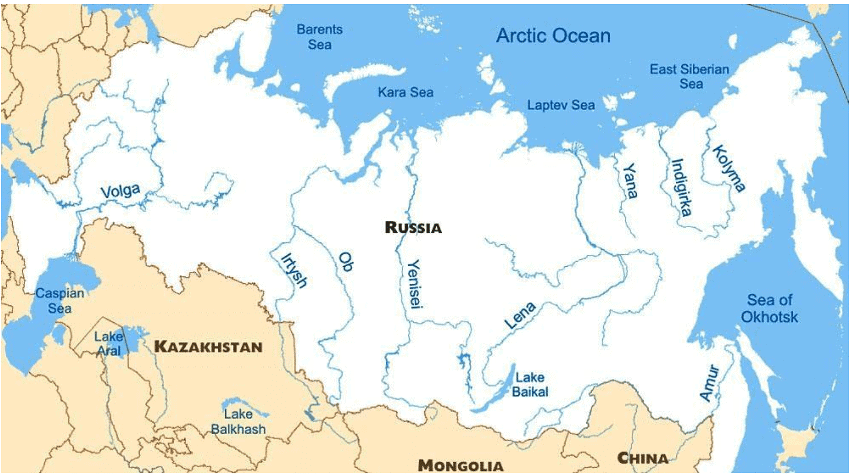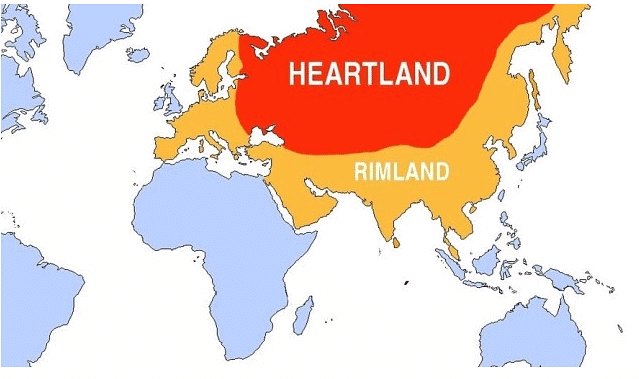Rimland Theories | Geography Optional for UPSC PDF Download
Heartland and Rimland theory
- These theories talk about the evolution of Geopolitics of the world
- Geopolitics is made up of 2 words, Geo & Politics which refers to the changes in Polity of the world due to Geographical factors
- The geopolitical history of the world has undergone a spatiotemporal analysis by political thinkers & geographers who had seen political history as the causation of geographical factors
- The conflict between land & sea power was 1st hypothesized by Alfred Thayer Mahan in his book “The Influence of Sea Power upon History” who emphasized that Sea Power is superior to Land Power because of easy & faster movement, port facilities, better trade, etc
- Sea Power refers to countries having a large sea boundary and Land Power refers to countries that are landlocked or have a large land boundary e.g. India has a long coastline while Nepal is a landlocked country
- However, a British Political Geographer Prof. H. J. Mackinder contradicted his theory and proposed a reverse, antithetical spatial model of Land & Sea Power conflict where the Supremacy of Land Power was due to its location, inaccessibility from all sides, and resource pass.
Mackinder’s Heartland Theory
- Mackinder’s theory is a spatial analysis of the geopolitics in terms of its location, accessibility, and natural resource base
- His theory has laid down the principle of geographical causation of history which means that the pulsations in human history have been caused by the geographical conditions
- Mackinder interpreted history as essentially a struggle between Land & Sea Power and presented his paper “The Geographical Pivot of History” in order to elucidate his formula of ‘Geographical Causation in World History‘
- The political history of the world, fates of civilization, and the changing paradigms of nations have been majestically controlled by Geographical Causation.
- Mackinder theorised the hypothesis of Geopolitical rivalry between Land Power and Sea Power and thus conflict led to several wars.
Actual Mackinder’s Theory
- He postulated the resource theory & location as a resource
- The natural resource endowment is the basis of sustenance of a country & its supremacy over others as well since natural resources are found on Land e.g. Nuclear Energy requires Uranium as a Raw material which is found mainly in Land
- On the basis of physical map of the world, Mackinder concluded that on the global scale, the earth surface consisted of a huge & continuous landmass (Europe, Asia, and Africa) and some isolated Islands e.g. North and South America, Australia, Great Britain, and Japan.
- He named this huge united landmass of Europe, Asia & Africa as the ‘World Island’ which accounts for 2/3rd of the total land area of Earth, being 11 Mn. Sq. Km and also about 7/8th or 88% of the total population of the world.
- The concept of World Island is central to the theoretical precepts of Mackinder
- The rest of the continents supported the only 1/8th of the mankind
- The concept of Heartland was later used in cold war discourse to denote an era of Eurasia
- Mackinder suggested that the Columbian era of Sea Power (Age of Discoveries with Columbus, Marco Polo, etc ) which had given Europe its pivotal role for the past 4 centuries (Colonial Era), was coming to a close & was being eclipsed by the ascendancy of Land-based powers & in particular with a new ‘Geopolitical pivot of History’ namely the Heartland of Europe-Asia.
Three Tiers
- Mackinder divided the world into 3 Tier spatially organized system
- In 1903, he published a book titled “Geographical Pivot of History” containing the following map.
 Heartland
Heartland
The 3 tiers were
- Pivot Area/Heartland: It is surrounded by mountains on three sides and by the ice-bound Arctic on the North
- It consisted of the whole Siberia & parts of Central Asia (Kazakhstan, Uzbekistan, Tajikistan, Kyrgyzstan, and Turkmenistan)
- It was surrounded by the vast icefields of Arctic in North, the Urals in West, Central Asian Highlands in South & East Siberian Highlands in East
- It was thus termed as a “Natural Fortress or the Uppermost Citadel of the world” as it was not accessible to sea powers
- The pivot area has a concentration of all-natural resources – mineral, water, soil, forest, etc.
- Inner Crescent: The Pivot Area was pictured by Mackinder as surrounded by an ‘Inner’ or ‘Marginal’ Crescent, consisting of an arch of coastland & characterized by drainage into navigable seas
- This inner or marginal crescent considered of the whole of Eurasia outside the heartland
- It symbolizes the Sea Power and includes
(i) Europe
(ii) South West Asia
(iii) North Africa
(iv) India
(v) China (some parts of China is in pivot area also) - Most of the Human civilizations are located in the crescent and it is co-terminus with the old world i.e. Pre-Columbian
3. Outer/ Insular Crescent: Outside the Inner or Marginal crescent lay Mackinder’s 3rd tier, which he named as the Outer or Insular crescent
- Mackinder suggested it to have no geographical significance in the contemporary world
- It included the New World (North America, South America, Other parts of Africa, Pacific Islands, Oceania)
- It is designated as Outer Crescent because of their complete insularity from the mainland of Eurasia
- For Mackinder, the concept of World Island is central to this theoretical percept
- For him, whoever could gain control of ‘World Island’ would be in an almost unstoppable position to dominate the entire globe
- In his opinion, the heartland having Agricultural resources could conquer Europe, Middle East & Far East
- The inner and outer crescent would follow later

Modified Concept of Strategic Heartland, 1919
- In 1919, he modified his theory & presented in his book “Democratic Ideals and Reality”
- It was a much elaborate theory & probably the most voluminous work in the entire political geography
- The Pivot Area was modified & he called it Heartland.
Modified Strategic Heartland
- He redefined Heartland as the region to which sea power can be refused access
- Heartland was much larger & it included the Volga Basin, Steppes, Himalayas, Baltic Sea, Black Sea, Asia Minor, etc
- Because of the fall of the Russian empire and the emergence of the USSR as a superpower (Bolshevik Revolution), Mackinder became more assertive in his theory of Heartland
- The world power seemed to be centralized around the Heartland which he said had all the resources and natural defense by the physiographic factors
- It is invincible and represents the supremacy of Land Power
- He considered the South West Ukrainian Steppes as the only gateway to the Heartland – It was called South Western Corridor
- His 2nd tier or the Inner Crescent now included the British Isles & the whole of Africa
- The outer crescent consisted of New WorldMackinder’s famous dictum caught the attention of the World
(i) “Who rules East Europe commands the Heartland?”
(ii) “Who rules Heartland commands the World-Island?”
(iii) “Who rules the World-Island commands the World?” - The key to control the Heartland, Mackinder later argued, lay in Eastern Europe
- The ‘Heartland’ is the strongest fortress on Earth, commanding resources of a huge Trans-Continental Area. Any power that could organize it effectively was bound to emerge as a great power in world politics.

Modified Concept of Midland basin, 1943
- Until 1919, Mackinder had confined his attention to Eurasia and the old world and did not give any attention to the New World
- In the 1920s, he claimed that the west of Europe and east of North America are physical complements of one another
- During the Second World War, Mackinder’s theory was put to test. The Heartland could have become the focus of power if either Russia had united with Germany or Russia had been overthrown by China or Japan
- In the 2nd World War (1939-45), the USA emerged as another superpower and the intense geopolitical rivalry between USSR and US-UK combine was foreseeable
- The outcome of World War was palpable in the early 1940s, therefore Mackinder was quick to reverse his theory before his death in 1943, in a magazine, “Foreign Affair”, where he published his theory – “The Round World and the Winning of the Peace”
- In the paper, Mackinder clearly recognized that the two sides of the North Atlantic were bound together
- He postulated a new idea of Midland Basin, where he included US-UK combine as the parallel world power to the Heartland (Mainly, USSR)
- Midland Basin included the countries that surrounded the Midland Ocean i.e. Western Europe (France, Belgium, Britain, etc) and North America
- He regarded this area as an effective counterbalance to the emerging political power potential of Eurasian Heartland
- He stated that the UK & New England regions of the USA (older regions of 6 colonies) have a single race of people, uniform cultures, isotropic geographical conditions, similar resource base. Thus, they are one civilization.
- The North Atlantic water present no obstacle to their interaction rather it is a facilitator due to similar features
- Thus, there is a definite political communion between these 2 nations and at the geopolitical front, the present a unitary coherent picture
- Thus, there are 2 power centers in World
(i) Heartland (Mainly, USSR)
(ii) Midland Basin (Mainly, US-UK combine) - In 1943, he excluded from the heartland that part of the Soviet Union lying to the east of the Yenisei River. He named it as Lena Land.
- Owing to its rugged topography and forest cover, this region was of little economic value
- He envisioned the 2 centers of power- Heartland & Midland, to be surrounded & insulated by a guide of deserts – Sahara, Arabian, Iranian, Tibetan, and Mongolian, extending through the rugged and desolate Lena Land to Alaska, the Canadian Arctic, and the deserts of Western America
- Mackinder thought that this empty land and deserts will prevent the spread of conflict to the outside world.
 Midland Basins
Midland Basins
Applications of the Mackinder’s Theory
The applications of the Mackinder’s Theory can be divided into –
- Pre Cold War
- Cold War
- Post-Cold War
Pre Cold War (before 1945)
- Bolshevik Revolution & emergence of Russia as a Superpower (Land Power)
- Outcome of 1st World War and the defeat of Germany (Sea Power)
- World Geopolitics hovering around East Europe
- Spread of Communism in East Europe under influence of USSR
- Contemporary history between 1st World War and 2nd World War has many events that can lead us to believe that Mackinder was true in his conviction.
Cold War (1945-91)
- Heartland was represented by USSR & Midland by US-UK combine in the modified theory of Mackinder of 1943
- Cold War was a conflict between Capitalism & Socialism and not a proper war
- Most of the geopolitics was centered around either East Europe or West Asia which had the resources as well as peripheral location or transition location forming part of Inner Crescent
- Present Geopolitics can also be linked to it including Crimean Annexation, West Asian Crisis which are a part of Inner Crescent
- Major events were:
(i) Cuban Missile Crisis (1962): It demonstrated the power of Heartland & Midland as depicted by Mackinder in 1943
(ii) The event also showed power balance in the world which depicted 2 centre of powers in the world
(iii) The installation of missiles in East Europe by the USA was counteracted by USSR, installing the missiles at Cuba to threaten the USA
(iv) West Asian Crisis: It was where both USSR and USA were involved in forming a strategic alignment with countries to assert their power e.g. USSR with Iraq and Afghanistan, the USA with Saudi Arabia/Israel
(v) Geopolitics of India: Withdrawal of the UK from the Indian Ocean which was called the British Lake (1850s-1973) (initially Portuguese lake) and also loss of control of Suez Canal to Egypt. USA intervened in the Indian Ocean under the pretext that USSR can politicize and colonize the region and hence the region needs a power balance. So, the USA started constructing Naval Bases in the Indian Ocean. Wars in Indian Ocean such as Vietnam War, Korean War, etc showed Power Balance.
Post-Cold War (After 1991)
- Unipolar world emerged with the USA and the Heartland had fallen
- With Shanghai Cooperation Organisation, the future can witness the re-emergence of Russia
- Russia has lost its economic power/Superpower but not the defense technology, strategic alignments
- A possible strategic triad between Moscow, Beijing, and New Delhi (BRICS)
- Multiple Alignments are taking place now and the world is shifting towards a Multipolar World.
Criticism
- He simplified history in a deterministic fashion as a struggle between land and sea powers, which is far from truth. History is influenced by Physical, Socio-Economic and Cultural factors with conflict of interest and not just Geographical Factors
- Mackinder constructed his theory on basis of Mercator’s Map Projection and he thought that the USA & Russia are 1000s of miles apart and that Arctic ice fields are largely expansive. But, actually, the USA is hundreds of miles from Siberia (Bering Strait)
- He wrongly equated power potential with the sheer geographical area, a factor that made him to overinflate the resources & power potential of the inner Asian Heartland e.g. the Sahara Desert has a vast area but barren, without any resources
- He tried to explain the present and prognosticate the future in terms of technology that has become outdated
- He overlooked the fact that Heartland was a region of permanent difficulties because of its interior location and owing to the extremes of Climate. It is too cold in winter and parts of it are hot and dry in summer, therefore owing to these Locational climatic factors, the Heartland is at a relatively disadvantage as compared to other larger & well-endowed area
- He could not foresee the air age and his theories are a product of the zenith of the Rail age in Europe. Heartland is easily accessible, crossing all the barriers, with the help of airplanes
- Heartland is not as resourceful as it is made out to be and the greater part of Heartland is a wasteland, incapable of supporting a large population
- With the development of technology and fast-moving fighters, ballistic and cruise missiles, the fortress i.e. Heartland now lay open to air raids from all sides, as much as any other place
- Nuclear deterrence is the new policy that emerged after the Japan Bombings
- It is a fact that geopolitics has migrated from Germany to North America after the 2nd World War and in the current scenario, Geopolitics is shifting towards Asia with China and India emerging as new power centers
- Geographical causation of history is questionable – Geographical factors are subordinate to man’s technology (Possibilistic thought – which says a man can overcome barriers by various means)
- With the rapid growth of Science & Technology, the Surface configuration of Earth has become much less significant politically than it was than it was at the time when Mackinder presented his ‘pivot area’.
- The real world was not flat but spherical, and the flat earth map used by Mackinder to utilize the pivot area thesis has led to a false sense of world geography.
Spykman’s Rimland Theory
- In 1944, Spykman as the point of critic or antithetic to the Heartland Theory presented his work titled “The Rimland Theory” in his book – “The Geography of Peace”
- He gave a different interpretation of the relative importance of Heartland (Land Power) vis-a-vis the surrounding Inner and Outer Crescent
- His theory has been based on the 2 basic postulates of Mackinder:
(i) Geographical Causation of History
(ii) The conflict between Land Power and Seapower - Spykman, based on the same premises, built a new geopolitical model where the Sea Power was supreme and Land Power being inaccessible is inferior
- Sea Power has faster movement, greater accessibility while Land can be inaccessible due to hills, rivers, deserts, etc
- Sea Powers have more than 2/3rd population of the world and thus full of human & technological resources. Most of the population is located on Coastal areas
- Spykman considered geographical features as important determinants in foreign policy because of its emphasis on spatial variations
- In medieval human history and the pre-modern era, Naval Power had supremacy over the Land power as they had Navigation Technology, Ships, etc. e.g. British, French, German, Portuguese, Spanish, Italy were all sea powers and whole world became the colonial house of these countries
- Spykman gave emphasis on maritime mobility as the basis of a new type of geopolitical structure
- According to Spykman, it is the sea power that governs the relationships between Old and New Worlds
- To Spykman, the Heartland appeared “less important than the Rimland” as Heartland could not support a large population due to extremes of climate in Central Siberia
- He was convinced that it is a combination of land and sea powers controlling the Rimland that would in all probability control the “essential power relations of the world”.

2 Tier System (Inner Core & Rimland)
He divided the world in 2 tier system –
1. Inner Core
- It is similar to the Heartland
- He said that Heartland is a region of Physiographic difficulties with barriers and extreme climatic constraints such as Siberia
- The resources are dormant
- Human Population is absent
- It is neither a natural fortress nor the protected Land
- It is pilferated from many parts allowing access to others such as the central Asian deserts, Steppes, Low mountains, River Valleys are several gateways
- Moreover, this region is inhabited by Tribals and has primitive civilization and by no means it can affect the geopolitics of the world. It is a Land of Miseries with no prosperity.
2. Rimland
- Similar to the Inner Crescent and has all the majestic sea powers, which scripted the history of modern civilization
- All the area of Rimland is connected to water i.e. The seas or oceans e.g. China, India, ASEAN Countries, Gulf Countries, etc
- To Spykman – “Heartland appeared less important than the Rimland” and his famous dictum was
“Who controls the Rimland rules Eurasia, Who rules Eurasia controls the destinies of the World”
Writing at the time when the 2nd World War was still on, Spykman advocated that the allied powers such as Britain, France, etc should base their future foreign policy on preventing any consolidation of Rimland and the enemy.
 Tier Rimland
Tier Rimland
Application
- In the era of Colonisation, Sea Power like the British, French, Portugal, Spain captured/demonstrated their superiority. The Naval power was significant
- Formation of the Indian Ocean Rim (including Australia & NZ) is an effort to consolidate the rimland through Regional Groupings such as BISMTEC, IOR-ARC, etc
- Other groups like ASEAN have a focus on similar objectives
- Geopolitics of the Indian Ocean & all the world superpowers have entered the Indian Ocean – this also signifies the importance of Rimland e.g. Raisina Dialogue, Pivot to Asia policy of USA
- K.M. Pannicker had remarked in the 1970s
“Who controls the Rimland has India at its mercy” - USA intervention in West Asia & Gulf Countries
- During the cold war period: Eastern Europe was the zone of contention between the superpowers
(i) Cuban Missile Crisis
(ii) National Missile Defence Strategy of USA - After 1950, all major wars were fought in Rimland
(i) North-South Korea
(ii) Sino India
(iii) Arab Israel War
(iv) Indo Pak war
(v) Gulf crisis
(vi) Afghanistan, Iran, Iraq war - With the defeat of Germany in the 2nd World War and the emergence of the USSR as the sole master of Heartland, Spykman’s prescription became the basis of American policies of Containment of Communism
- NATO, Baghdad Pact & subsequently, CENTO (Central Treaty Organization) & SEATO (Southeast Asia Treaty Organization) were made by the USA to keep an eye on the defense of Rimland mainly European and Asian Countries, and to prevent the Soviet influence in warm waters of Rimland.
Criticism
- Criticised on the ground of Advancement of war technology and Nuclear deterrence
- Spykman underestimated the role of the world community & UNO in promoting world peace
- World today is a global village and international law doesn’t permit territorial expansion i.e. Ratzel’s Lebensraum was no longer applicable which considered State as a living organism and motivated Hitler for a Greater German Reich
- It is the time of Economic imperialism and not that of Political colonization e.g. Flooding of Indian Markets by Chinese Goods.
Why Rimland is important than Heartland
- Rimland has more importance over Heartland because of the following reasons –
- At least 40% of the world resources are in the Rimland area such as Oil, Continental Shelf resources, etc
- Rimland countries have huge population e.g. India, China, etc
- Rimland countries are undergoing war against terror, the war against weapons of Mass Destruction (WMDs)
- Rimland consists mostly of developing Nations such as India, CLMV countries, Indonesia, etc.

|
304 videos|717 docs|259 tests
|
FAQs on Rimland Theories - Geography Optional for UPSC
| 1. What is the Heartland theory? |  |
| 2. What is the Rimland theory? |  |
| 3. What are the main differences between the Heartland and Rimland theories? |  |
| 4. Which theory has had a greater influence on geopolitical strategies? |  |
| 5. How do these theories relate to contemporary international relations? |  |
















